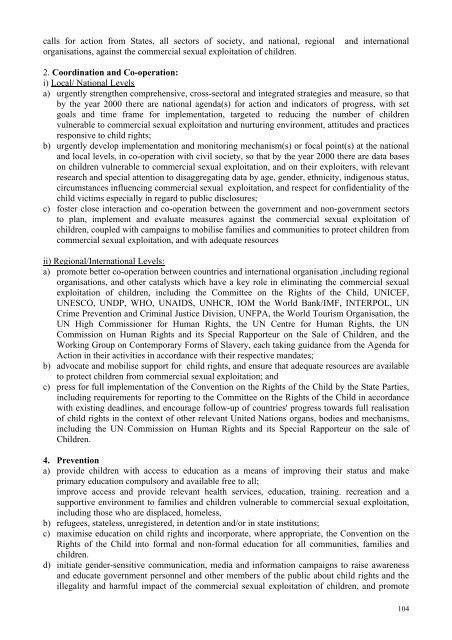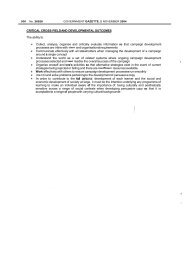The trafficking of children for purposes of sexual exploitation
The trafficking of children for purposes of sexual exploitation
The trafficking of children for purposes of sexual exploitation
You also want an ePaper? Increase the reach of your titles
YUMPU automatically turns print PDFs into web optimized ePapers that Google loves.
calls <strong>for</strong> action from States, all sectors <strong>of</strong> society, and national, regional and international<br />
organisations, against the commercial <strong>sexual</strong> <strong>exploitation</strong> <strong>of</strong> <strong>children</strong>.<br />
2. Coordination and Co-operation:<br />
i) Local/ National Levels<br />
a) urgently strengthen comprehensive, cross-sectoral and integrated strategies and measure, so that<br />
by the year 2000 there are national agenda(s) <strong>for</strong> action and indicators <strong>of</strong> progress, with set<br />
goals and time frame <strong>for</strong> implementation, targeted to reducing the number <strong>of</strong> <strong>children</strong><br />
vulnerable to commercial <strong>sexual</strong> <strong>exploitation</strong> and nurturing environment, attitudes and practices<br />
responsive to child rights;<br />
b) urgently develop implementation and monitoring mechanism(s) or focal point(s) at the national<br />
and local levels, in co-operation with civil society, so that by the year 2000 there are data bases<br />
on <strong>children</strong> vulnerable to commercial <strong>sexual</strong> <strong>exploitation</strong>, and on their exploiters, with relevant<br />
research and special attention to disaggregating data by age, gender, ethnicity, indigenous status,<br />
circumstances influencing commercial <strong>sexual</strong> <strong>exploitation</strong>, and respect <strong>for</strong> confidentiality <strong>of</strong> the<br />
child victims especially in regard to public disclosures;<br />
c) foster close interaction and co-operation between the government and non-government sectors<br />
to plan, implement and evaluate measures against the commercial <strong>sexual</strong> <strong>exploitation</strong> <strong>of</strong><br />
<strong>children</strong>, coupled with campaigns to mobilise families and communities to protect <strong>children</strong> from<br />
commercial <strong>sexual</strong> <strong>exploitation</strong>, and with adequate resources<br />
ii) Regional/International Levels:<br />
a) promote better co-operation between countries and international organisation ,including regional<br />
organisations, and other catalysts which have a key role in eliminating the commercial <strong>sexual</strong><br />
<strong>exploitation</strong> <strong>of</strong> <strong>children</strong>, including the Committee on the Rights <strong>of</strong> the Child, UNICEF,<br />
UNESCO, UNDP, WHO, UNAIDS, UNHCR, IOM the World Bank/IMF, INTERPOL, UN<br />
Crime Prevention and Criminal Justice Division, UNFPA, the World Tourism Organisation, the<br />
UN High Commissioner <strong>for</strong> Human Rights, the UN Centre <strong>for</strong> Human Rights, the UN<br />
Commission on Human Rights and its Special Rapporteur on the Sale <strong>of</strong> Children, and the<br />
Working Group on Contemporary Forms <strong>of</strong> Slavery, each taking guidance from the Agenda <strong>for</strong><br />
Action in their activities in accordance with their respective mandates;<br />
b) advocate and mobilise support <strong>for</strong> child rights, and ensure that adequate resources are available<br />
to protect <strong>children</strong> from commercial <strong>sexual</strong> <strong>exploitation</strong>; and<br />
c) press <strong>for</strong> full implementation <strong>of</strong> the Convention on the Rights <strong>of</strong> the Child by the State Parties,<br />
including requirements <strong>for</strong> reporting to the Committee on the Rights <strong>of</strong> the Child in accordance<br />
with existing deadlines, and encourage follow-up <strong>of</strong> countries' progress towards full realisation<br />
<strong>of</strong> child rights in the context <strong>of</strong> other relevant United Nations organs, bodies and mechanisms,<br />
including the UN Commission on Human Rights and its Special Rapporteur on the sale <strong>of</strong><br />
Children.<br />
4. Prevention<br />
a) provide <strong>children</strong> with access to education as a means <strong>of</strong> improving their status and make<br />
primary education compulsory and available free to all;<br />
improve access and provide relevant health services, education, training. recreation and a<br />
supportive environment to families and <strong>children</strong> vulnerable to commercial <strong>sexual</strong> <strong>exploitation</strong>,<br />
including those who are displaced, homeless,<br />
b) refugees, stateless, unregistered, in detention and/or in state institutions;<br />
c) maximise education on child rights and incorporate, where appropriate, the Convention on the<br />
Rights <strong>of</strong> the Child into <strong>for</strong>mal and non-<strong>for</strong>mal education <strong>for</strong> all communities, families and<br />
<strong>children</strong>.<br />
d) initiate gender-sensitive communication, media and in<strong>for</strong>mation campaigns to raise awareness<br />
and educate government personnel and other members <strong>of</strong> the public about child rights and the<br />
illegality and harmful impact <strong>of</strong> the commercial <strong>sexual</strong> <strong>exploitation</strong> <strong>of</strong> <strong>children</strong>, and promote<br />
104
















